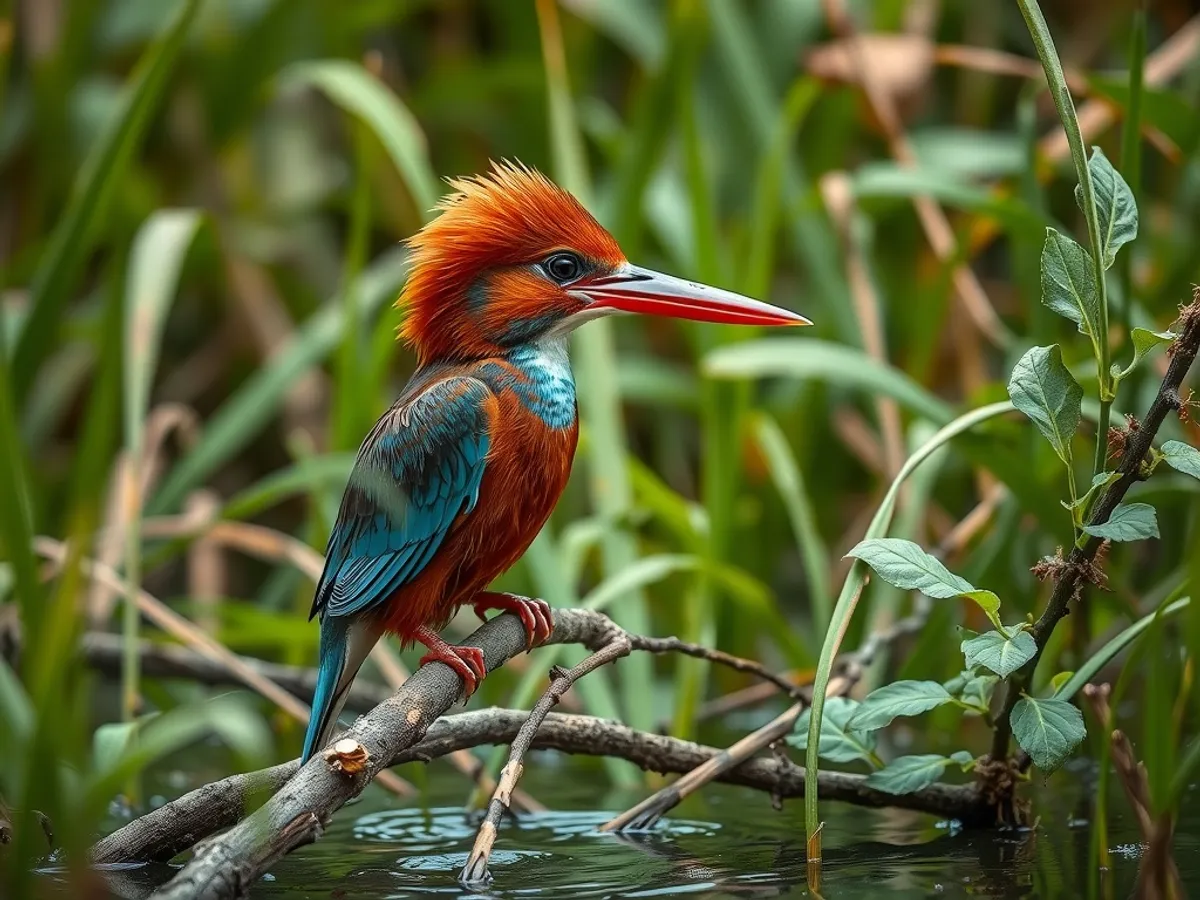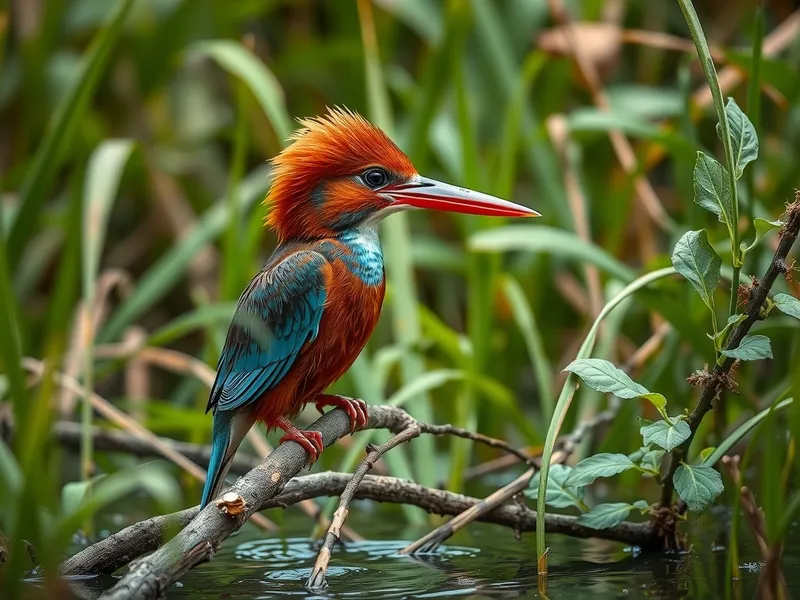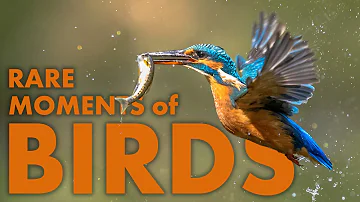
Malachite Kingfisher
Corythornis cristatus

Meet the Malachite Kingfisher
The Malachite Kingfisher is a small and vividly colored bird found widely throughout sub-Saharan Africa. It is characterized by its brilliant electric-blue upperparts, orange underparts, and a distinct crest with metallic blue and black markings. This kingfisher is typically seen perched quietly near slow-moving water, vigilantly searching for small fish and aquatic insects. Its rapid, direct flight and sharp, high-pitched call make it a striking presence along rivers, lakes, and marshes. Despite its dazzling plumage, the Malachite Kingfisher is highly skilled at remaining motionless and camouflaged among reeds.
Classification
Bird
Habitat
Freshwater wetlands, rivers, lakes, and marshes with dense vegetation
Diet
Carnivore
Lifespan
5-10 years
Conservation
Least Concern
Weight
12-19 g
📖Fascinating Facts
Expert Fisher
Malachite Kingfishers hunt by perching quietly above water, then darting down to snatch fish or aquatic insects with incredible speed and precision.
Riverbank Dwellers
They excavate nesting tunnels directly into sandy riverbanks, often several feet long, to lay their eggs safely away from predators.
Jewel-Like Plumage
Their vibrant blue and orange plumage is not due to pigment, but to microscopic structures in their feathers that reflect and refract light.
📋Detailed Description
The Malachite Kingfisher (Corythornis cristatus) is a diminutive, strikingly colorful bird measuring 13–14 cm in length and weighing approximately 12–19 grams. Its most distinctive features include a vivid metallic blue crown with black-edged feathers forming a short, spiky crest, and a deep azure-blue back, wings, and tail. The underparts are a rich rufous-orange, contrasting with a white throat and collar. The bill is long, straight, and dagger-like—bright red in adults and blackish in juveniles—adapted for catching aquatic prey. The legs and feet are also bright red. The eyes are dark brown, positioned for excellent binocular vision, aiding in precise prey capture. Sexual dimorphism is minimal, though females may have slightly duller plumage. The species is highly territorial and solitary outside of the breeding season, often seen perched low over water, remaining motionless before plunging headfirst to seize prey. Its rapid, direct flight is characterized by whirring wings and a short, sharp 'tsip' call. The Malachite Kingfisher is distributed across sub-Saharan Africa, inhabiting a wide range of freshwater wetlands, including slow-moving rivers, lakes, marshes, and ponds with abundant emergent vegetation. Its cryptic behavior and vibrant coloration make it both elusive and unmistakable when seen.
💡 Did you know?
Despite their small size, Malachite Kingfishers can consume fish nearly as long as their own bodies!
🔬Research & Sources
Wikipedia Summary
The malachite kingfisher is a river kingfisher which is widely distributed in Africa south of the Sahara. It is largely resident except for seasonal climate-related movements.
Last Modified: 2/10/2024
🎭Behavior & Social Structure
Malachite Kingfishers are diurnal and crepuscular, most active during early morning and late afternoon when prey is abundant. They are sit-and-wait predators, perching quietly on reeds or low branches near water, scanning for small fish, aquatic insects, crustaceans, and occasionally tadpoles. When prey is spotted, they dive swiftly, using their sharp bill to snatch it, then return to the perch to manipulate and swallow it headfirst. They are highly territorial, defending feeding and nesting sites with aggressive displays and vocalizations. Social interactions are generally limited to mating pairs and parent-offspring groups; otherwise, individuals are solitary. Bathing and preening are frequent, with birds often seen dipping into water or sunning themselves to maintain plumage condition. They are known to cache surplus food in crevices or dense vegetation near their territory.
👶Reproduction & Life Cycle
Breeding occurs during the rainy season, varying regionally but generally coinciding with peak food availability. Courtship involves aerial chases and mutual feeding displays. Both sexes excavate a horizontal tunnel (30–90 cm long) in a riverbank or steep earth embankment, ending in a nesting chamber. The female typically lays 3–6 glossy white eggs, which are incubated by both parents for about 14–16 days. After hatching, both parents feed the altricial chicks, which fledge at 19–21 days old. Parental care continues for several days post-fledging. Pairs are monogamous during the breeding season, and may reuse or renovate old nest burrows in subsequent years.
🛡️Adaptations & Survival
The Malachite Kingfisher exhibits several adaptations for its aquatic lifestyle. Its compact, streamlined body and short tail facilitate rapid, agile flight and precise diving. The bill is specialized for spearing and grasping slippery prey. Dense, waterproof plumage and a unique arrangement of powder down feathers help maintain buoyancy and insulation. The eyes possess a nictitating membrane, protecting them underwater and enabling accurate refraction correction. Zygodactyl feet (two toes forward, two backward) provide a strong grip on perches. Cryptic behavior and the ability to remain motionless aid in both predation and predator avoidance. The bird's vibrant coloration, while conspicuous to humans, blends with the dappled light and water reflections of its habitat, providing camouflage.
📚Research Sources
🎨Cultural Significance
The Malachite Kingfisher is admired in many African cultures for its dazzling beauty and is often featured in folklore as a symbol of peace, prosperity, and agility. Its appearance is sometimes considered an omen of good fortune, especially among communities living near rivers and lakes. The bird's feathers have occasionally been used in traditional adornments, though not to the extent of some other kingfisher species. It is a popular subject in African art and ecotourism, contributing to local economies through birdwatching activities.
🔬Recent Research & Discoveries
Recent research has focused on the Malachite Kingfisher's foraging efficiency, visual adaptations for underwater hunting, and the impact of habitat fragmentation on genetic diversity. Studies using stable isotope analysis have revealed dietary flexibility in response to seasonal prey abundance. Ongoing projects are examining the effects of water pollution on reproductive success and chick development. Advances in bioacoustics have helped clarify the species' vocal repertoire and its role in territory defense. Genetic studies indicate low differentiation among subspecies, supporting the view of a single, widespread species with minor regional variation.
🎥Wildlife Videos

Malachite Kingfishers | A Bird's Eye View - Episode 1
A Bird's Eye View, a birding videography series that takes you closer than ever before to some of Southern Africa's most colourful ...
Richard van Haght

Kingfishers - The Gift of Nature (flying rainbow) | Go Wild
The Oriental Dwarf Kingfisher is one of the most enigmatic and rarely filmed birds in the world. This fascinating documentary ...
Go Wild

Malachite Kingfisher spreads its crown in slow-motion by Lisle Gwynn
Malachite Kingfishers are seen on just about every Africa tour that we conduct, for more see ...
Tropical Birding

Kingfisher - The Hunt for Germany's Flying Diamond | Free Documentary Nature
Kingfisher - The Hunt for the Flying Diamond | Free Nature Documentary This is the story of an animal filmmaker who fulfilled a ...
Free Documentary - Nature

Secret Life of the Kingfisher | Discover Wildlife | Robert E Fuller
From early courtship to their chicks' first flights, discover the secret life of the kingfisher. Watch more kingfisher films here: ...
Robert E Fuller

AMAZING LIFE OF BIRDS | Full Wildlife Documentary
This video is dubbed in 8 languages: Welcome to Amazing World of Birds — a ...
Wildlife Film Central
🌍Habitat Information
The Malachite Kingfisher typically inhabits Freshwater wetlands, rivers, lakes, and marshes with dense vegetation environments. Malachite Kingfishers have adapted to their environments with specialized features and behaviors.
Primary Habitat:
Freshwater wetlands, rivers, lakes, and marshes with dense vegetation
More detailed habitat information will be available soon.
🛡️Conservation Status
The Malachite Kingfisher is currently classified as Least Concern. Conservation efforts are crucial for preserving this species for future generations.
Common Threats:
- 🏠Habitat loss and fragmentation
- 🌡️Climate change impacts
- 🎯Hunting and poaching
- 🏭Human-wildlife conflict
⚠️Threats & Conservation Challenges
Currently assessed as Least Concern by the IUCN, the Malachite Kingfisher maintains stable populations across its range. However, localized threats include habitat degradation from wetland drainage, pollution, siltation, and the loss of riparian vegetation due to agriculture and urbanization. Pesticide runoff can reduce prey availability and pose direct toxicity risks. Climate change may alter rainfall patterns, impacting breeding success and food resources. Despite these challenges, the species' adaptability to a range of freshwater habitats and its broad distribution buffer it against severe declines. Continued monitoring is recommended, especially in regions experiencing rapid environmental change.
🔬Scientific Classification
Scientific Name
Corythornis cristatus
Classification Hierarchy
🔍 About Taxonomic Classification
Taxonomic classification is a hierarchical system used by scientists to classify and organize living organisms based on shared characteristics and evolutionary relationships.
The system moves from broad categories (Kingdom) to increasingly specific ones, with each animal's scientific name typically consisting of its Genus and species.
📝Community Notes
Share your observations and insights about the Malachite Kingfisher with our community of wildlife enthusiasts.
Join Our Community
Sign in to share your observations and connect with fellow wildlife enthusiasts.
Sign In to ContributeNo community notes yet
Be the first to share your observations about the Malachite Kingfisher!
Explore Malachite Kingfisher
Select a tab above to learn more about this amazing animal.
📸Photo Gallery
No photos available for this animal yet.
🌟Discover More Wildlife
Continue your journey of discovery with more fascinating animals from our database
